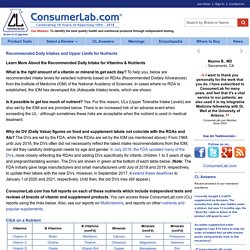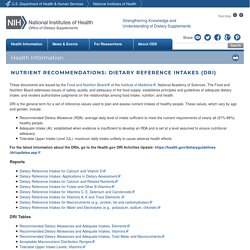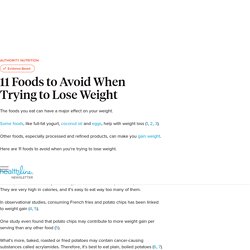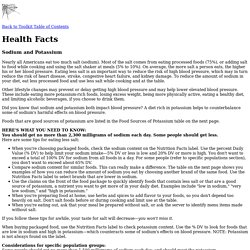

Blood pressure chart: What your reading means. Facts About Blood Pressure. Recommended Daily Intakes for Vitamins & Nutrients. What is the right amount of a vitamin or mineral to get each day?

To help you, below are recommended intake levels for selected nutrients based on RDAs (Recommended Dietary Allowances) from the Institute of Medicine (IOM) of the National Academy of Sciences. In cases where no RDA is established, the IOM has developed AIs (Adequate Intake) levels, which are shown. Is it possible to get too much of nutrient? Yes. For this reason, ULs (Upper Tolerable Intake Levels) are also set by the IOM and are provided below.
Why do DV (Daily Value) figures on food and supplement labels not coincide with the RDAs and AIs? 2015-2020 Dietary Guidelines - health.gov. All about the Protein Foods Group. Daily Intake Guide: Healthy eating, made easy. Front-of-pack labelling for food and drink in Australia. - How to read DIG. Nutrient Recommendations : Dietary Reference Intakes (DRI) These documents are issued by the Food and Nutrition Board of the Institute of Medicine , National Academy of Sciences.

The Food and Nutrition Board addresses issues of safety, quality, and adequacy of the food supply; establishes principles and guidelines of adequate dietary intake; and renders authoritative judgments on the relationships among food intake, nutrition, and health. DRI is the general term for a set of reference values used to plan and assess nutrient intakes of healthy people. These values, which vary by age and gender, include: Recommended Dietary Allowance (RDA): average daily level of intake sufficient to meet the nutrient requirements of nearly all (97%-98%) healthy people.
Reports DRI Tables. 11 Foods to Avoid When Trying to Lose Weight. The foods you eat can have a major effect on your weight.

Some foods, like full-fat yogurt, coconut oil and eggs, help with weight loss (1, 2, 3). Other foods, especially processed and refined products, can make you gain weight. Here are 11 foods to avoid when you're trying to lose weight. Whole potatoes are healthy and filling, but french fries and potato chips are not. They are very high in calories, and it's easy to eat way too many of them. In observational studies, consuming French fries and potato chips has been linked to weight gain (4, 5). One study even found that potato chips may contribute to more weight gain per serving than any other food (5). What's more, baked, roasted or fried potatoes may contain cancer-causing substances called acrylamides. Bottom Line: French fries and potato chips are unhealthy and fattening. Sugar-sweetened beverages, like soda, are one of the unhealthiest foods on the planet.
White bread is highly refined and often contains a lot of added sugar. The Best Basic Tips For Cutting Out Processed Foods. Deconstructing Food Labels in 8 Easy Steps. When you put together your new bedframe, I bet you read all the instructions before slapping all the pieces together—either that or you had to take it apart mid-assembly and start over again.

With any new piece of furniture, form of technology, or mechanical item, you’d do the same, read the instructions first. So why do a large majority of North Americans put food in their bodies without even scanning food labels? It seems logical, right? From calories to carbohydrates, and from proteins to sodium levels, let’s take some time to properly deconstruct a typical food label and consider the nutritional content of the foods we’re eating… 1. Health Facts: Sodium and Potassium. Back to Toolkit Table of Contents Sodium and Potassium Nearly all Americans eat too much salt (sodium).

Most of the salt comes from eating processed foods (75%), or adding salt to food while cooking and using the salt shaker at meals (5% to 10%). On average, the more salt a person eats, the higher his or her blood pressure. Eating less salt is an important way to reduce the risk of high blood pressure, which may in turn reduce the risk of heart disease, stroke, congestive heart failure, and kidney damage.
Other lifestyle changes may prevent or delay getting high blood pressure and may help lower elevated blood pressure. Did you know that sodium and potassium both impact blood pressure? Foods that are good sources of potassium are listed in the Food Sources of Potassium table on the next page. HERE'S WHAT YOU NEED TO KNOW: You should get no more than 2,300 milligrams of sodium each day. When you're choosing packaged foods, check the sodium content on the Nutrition Facts label.
TestMax Nutrition. Male Hormone Nutrition Checklist: Now before you start researching the best pro-test and estrogen blocking foods… you need to understand that woofing down large amounts of these foods regularly will not help.

The key is to eat the perfect amount needed for a older man... I call this the "Male hormone Ratio. " You see, if you eat too much of these test boosting foods, not only will it stress out your body and cause an even greater decrease in your hormone levels... You'll also be loading up on way too many calories and end up adding on more belly fat. And on the opposite end... if you don't consume enough, you'll see little to no change. That's why it's very important for you to consume a specific combination and amount of unique test-boosting and estrogen blocking foods that, when eaten together, automatically help support your male hormone levels.
Each phase of the meal plan is designed to gradually optimize your male hormones by first boosting your metabolism.